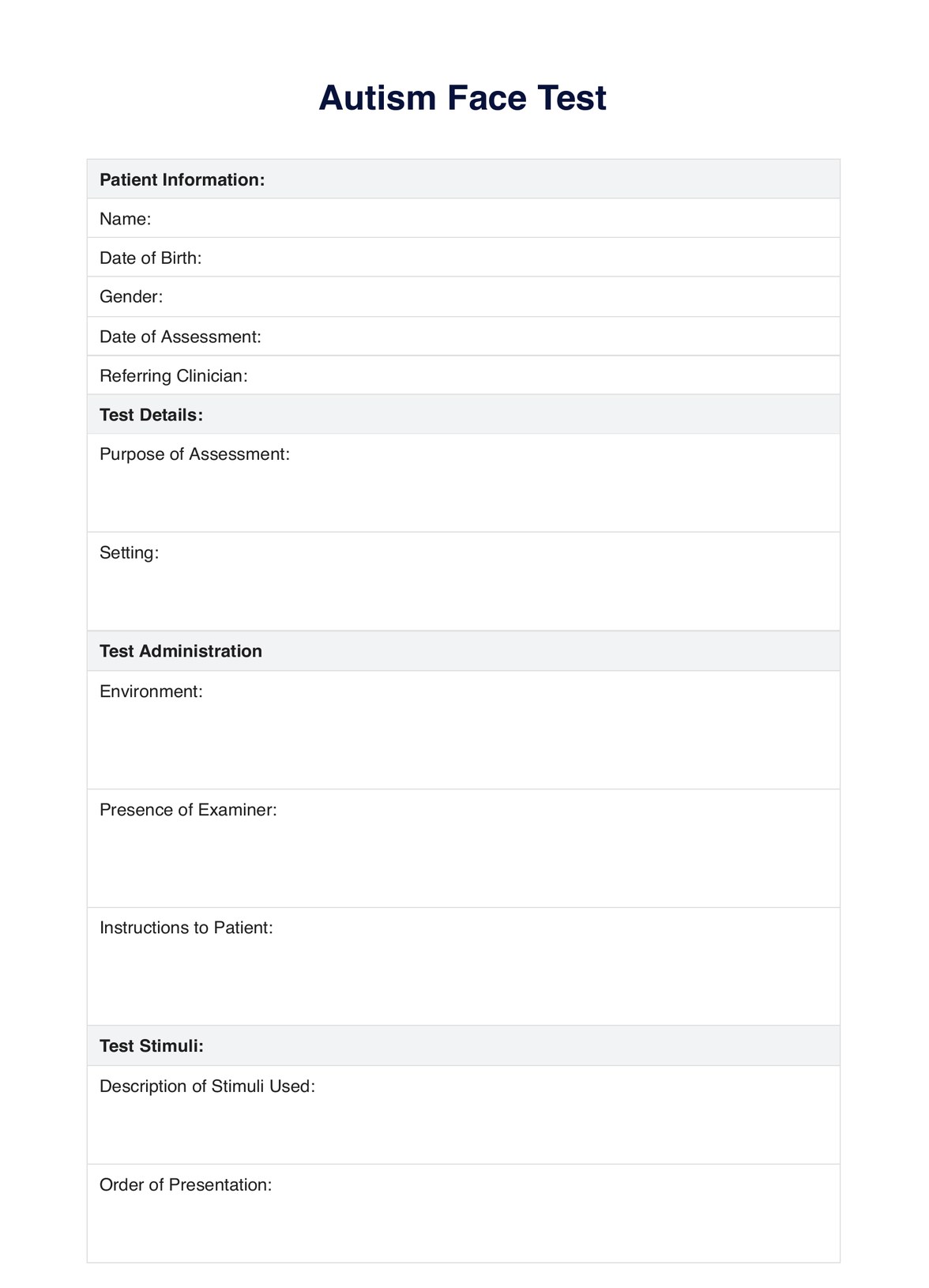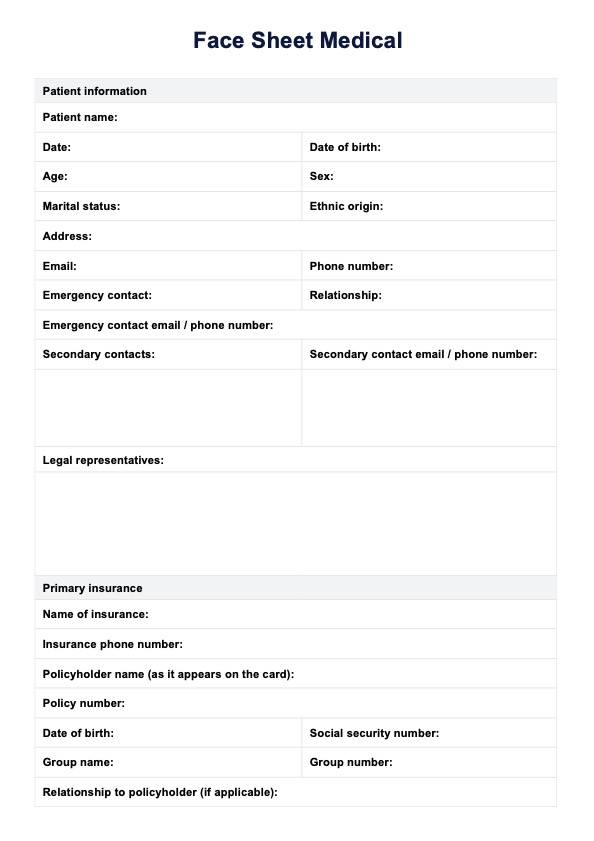Autism Face Test
Uncover autism-related facial expressions with the Autism Face Test, a tool for enhanced social cue recognition


Introduction to autism
Autism spectrum disorder (ASD) is a complex neurodevelopmental condition that influences how individuals perceive and engage with the world. The spectrum nature of autism underscores the diversity in its manifestation, with varying degrees of intensity and unique characteristics from high functioning to low-functioning individuals. Key aspects of autism involve challenges in social communication and interaction, as individuals may struggle with understanding and responding to social cues, maintaining eye contact, and participating in reciprocal conversations. Additionally, preferences for solitary activities and difficulties in comprehending and expressing emotions are common traits.
A distinctive feature of autism includes restricted and repetitive behaviors, such as hand-flapping, rocking, or the establishment of rigid routines, with disruptions causing distress and anxiety. Sensory sensitivities further contribute to the complexity of autism, as individuals may experience heightened or diminished responses to stimuli like loud noises, bright lights, or specific textures, impacting their daily experiences.
Despite the challenges, individuals with autism often exhibit unique strengths and talents. Exceptional memory, attention to detail, and creative abilities are among the positive attributes that should be recognized and nurtured. Embracing the diversity within the autism spectrum and appreciating the strengths that individuals bring to their communities is essential for fostering understanding and inclusivity.
Autism Face Test Template
Autism Face Test Example
What is the autism face test?
The Autism Face Test represents a groundbreaking tool in the realm of autism research, specifically focusing on the intricate domain of facial expressions. Developed by prominent figures in science such as Baron Cohen, this test provides a unique avenue for exploring the ways in which individuals on the autism spectrum perceive and interpret emotions conveyed through facial cues.
This test stands out as an interesting and scientifically rigorous approach to understanding the challenges faced by autistic individuals in recognizing and responding to various emotions. Rooted in scientific research methodologies, the Autism Face Test aims to uncover the connections between a person's mental state, their ability to decipher emotions, and the subtleties embedded in facial expressions.
While the Autism Face Test is not intended to replace a formal diagnosis, it serves as a crucial supplementary tool. It offers valuable insights into the experiences of those on the autism spectrum, providing a nuanced perspective that extends beyond traditional diagnostic criteria. By presenting a series of carefully curated pictures of familiar others, the test assesses the age at which individuals may encounter difficulties in recognizing different facial expressions, contributing to a better understanding of the unique challenges faced by autistic individuals.
As we begin to navigate the intricacies of the Autism Face Test, it becomes evident that this tool not only contributes to the scientific discourse surrounding autism but also holds the potential to foster increased awareness and empathy. By providing tangible evidence of difference and a novel approach to understanding emotional recognition differences, the Autism Face Test stands at the forefront of efforts to enhance our collective comprehension of autism and pave the way for more inclusive and supportive approaches to neurodiversity.
How does this assessment work?
The Autism Face Test is an assessment designed to explore the intricacies of facial expressions in individuals on the autism spectrum. Developed within the context of autism research, this innovative test sheds light on how autistic people perceive and interpret emotions conveyed through facial cues.
Scientific in nature and rooted in methodologies designed by influential figures like Baron Cohen, the tests focus on gauging and being able to recognize the difficulty that autistic individuals may face in understanding a diverse range of emotions. The assessment involves presenting a series of pictures that aim to determine the age at which individuals may encounter challenges in identifying facial expressions, examining emotional expression recognition differences between autistic and neurotypical individuals.
Through the autism face test, created based on scientific research, the assessment delves into a person's mental state, exploring their ability to navigate emotions and facial expressions. Unlike a formal diagnosis, this test serves as an interesting tool within the broader spectrum of autism research, offering valuable insights into the unique perspectives of individuals diagnosed on the autism spectrum.
By introducing a novel approach to understanding emotional recognition differences, the Autism Face Test not only contributes to scientific understanding but also holds the potential to foster increased awareness and empathy. This assessment stands as a testament to ongoing efforts in autism research, providing tangible evidence and a unique perspective on the emotional experiences of those navigating life on the spectrum.
Interpreting the results
High accuracy across expressions:
If an individual consistently demonstrates high accuracy in recognizing a variety of facial expressions, it may suggest that their ability to interpret emotions through facial cues is well-developed. This can be indicative of strong social and emotional processing skills.
Difficulty recognizing specific emotions:
If there are consistent challenges in identifying specific emotions (e.g., difficulty recognizing happiness, anger, surprise, or sadness), it may suggest areas where the individual experiences difficulty in social or emotional processing.
Varying recognition across age groups:
Differences in emotional expression recognition across age groups may highlight developmental patterns. If an individual has more difficulty recognizing emotions in younger or older faces, it could indicate a particular stage of social or emotional development.
Inconsistency in responses:
Inconsistencies in recognizing facial expressions throughout the test may suggest challenges in maintaining a standardized interpretation. This could indicate fluctuations in social or emotional processing abilities.
Similarities to neurotypical responses:
If the individual's responses closely align with neurotypical patterns, it may suggest the possibility that their facial expression recognition is within typical ranges. However, it's essential to consider the context and the specific emotions being assessed.
Distinctive response patterns:
Unique or distinctive patterns in responses might indicate a personalized approach to facial expression recognition. It's important to consider individual differences in processing emotions.
Proactive measures and support:
The results can inform proactive measures and support strategies. For example, interventions may be tailored to address specific challenges or capitalize on existing strengths in social and emotional interactions.
Next steps for diagnosis
Consultation with healthcare professionals:
Schedule an appointment with a healthcare professional, such as a pediatrician, psychiatrist, psychologist, or developmental specialist, to discuss the concerns raised by the Autism Face Test.
Comprehensive assessment:
The healthcare professional will conduct a comprehensive assessment, which may include clinical interviews with the individual and their caregivers, behavioral observations, and standardized assessments specifically designed for autism diagnosis.
Medical history review:
Provide a detailed medical history, including developmental milestones, social interactions, communication skills, and note any observed challenges in social or emotional processing.
Observation of social behaviors:
The professional will observe and assess social behaviors, communication skills, and interactions in various settings to gain a comprehensive understanding of the individual's social and emotional functioning.
Use of standardized diagnostic tools:
Standardized tools, such as the Autism Diagnostic Observation Schedule (ADOS) and the Autism Diagnostic Interview - Revised (ADI-R), may be utilized to aid in the diagnostic process.
Collaboration with multidisciplinary team:
Diagnosis often involves collaboration among a multidisciplinary team of professionals, including psychologists, speech therapists, occupational therapists, and educators.
Feedback and recommendations:
Following the assessment, healthcare professionals will provide feedback on the diagnostic findings, offer recommendations for intervention and support, and discuss potential treatment options.
Development of individualized plan:
Based on the diagnosis, an individualized plan can be developed to address specific challenges and strengths related to autism. This may involve behavioral interventions, social skills training, speech therapy, occupational therapy, or other specialized interventions.
Ongoing monitoring and support:
Ongoing monitoring and support are essential. Regular follow-up appointments and assessments help track progress and adjust interventions as needed.
Benefits of using this assessment
The Autism Face Test offers a range of benefits as a valuable supplementary tool in the assessment process. Through early identification, this assessment provides crucial opportunities for early intervention, allowing tailored support strategies to be implemented at a young age and significantly impacting social and emotional development.
By offering insights into specific challenges in facial expression recognition, the test facilitates the development of personalized approaches to social skills training, ensuring interventions are precisely tailored to individual needs. Serving as an objective assessment tool, it complements other diagnostic methods and enhances overall diagnostic clarity.
Moreover, the test fosters improved communication and understanding between individuals, their families, and healthcare providers, contributing to a more comprehensive evaluation of social and emotional processing challenges.
The data collected also contributes to ongoing autism research, advancing our collective understanding and fostering increased awareness and empathy for those on the autism spectrum. Ultimately, the Autism Face Test plays a vital role in initiating proactive measures and supporting individuals in navigating their unique social and emotional landscapes.
Other Tests Related to Autistic Traits
Autism spectrum quotient (AQ) test: The AQ test is a widely used self-report questionnaire designed to measure autistic traits in adults. It assesses various domains, including social skills, attention to detail, communication, and imagination.
Childhood autism spectrum test (CAST): Similar to the AQ test, the CAST is a screening tool specifically designed for children. It helps identify potential signs of ASD in children between the ages of 4 and 11.
Social responsiveness scale (SRS): The SRS is a comprehensive tool that assesses social behaviors and social impairments associated with ASD. It is often used in clinical and research settings to evaluate social functioning across different age groups.
Vineland adaptive behavior scales (Vineland-3): While not specific to autism, the Vineland-3 assesses adaptive behaviors, communication, daily living skills, and socialization. It provides a comprehensive overview of an individual's functional abilities, often used in the assessment of developmental disorders, including ASD.
Autism diagnostic observation schedule (ADOS): The ADOS is a semi-structured assessment designed to observe and evaluate social interaction, communication, and play in individuals suspected of having ASD. It is often used as part of the diagnostic process.
Gilliam autism rating scale (GARS): The GARS is a behavior rating scale that helps identify and assess the severity of autism symptoms. It covers various domains, including social interaction, communication, and repetitive behaviors.
Modified checklist for autism in toddlers (M-CHAT): The M-CHAT is a screening tool designed for toddlers between 16 and 30 months of age. It helps identify early signs of ASD by assessing social, communication, and play behaviors.
Reading the Mind in the Eyes Test (RMET): The RMET assesses an individual's ability to understand others' mental states by looking at pictures of eyes and choosing the corresponding emotion or mental state. It provides insights into theory of mind abilities.
Commonly asked questions
The Autism Face Test is an assessment tool that explores how individuals on the autism spectrum perceive and interpret emotions conveyed through facial expressions.
The test involves presenting a series of pictures depicting various facial expressions, evaluating the individual's ability to recognize and interpret emotions to provide insights into their social and emotional processing.
No, the Autism Face Test is not a diagnostic tool; it serves as a supplementary assessment to understand facial expression recognition patterns. A formal diagnosis requires a comprehensive evaluation by healthcare professionals.





















-template.jpg)



















































































